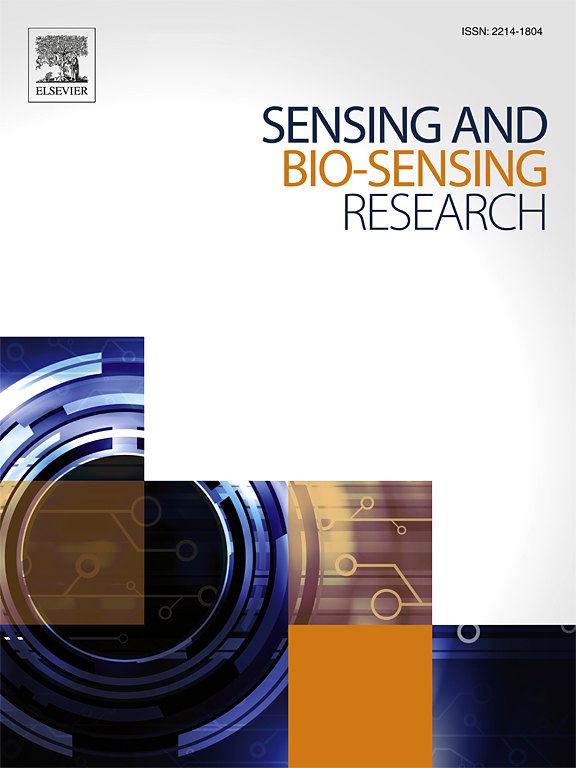Fabrication of folic acid immobilized graphene oxide-silica (FA@GO-SiO2) for the electrochemical detection of circulating tumor cells
IF 5.4
Q1 CHEMISTRY, ANALYTICAL
引用次数: 0
Abstract
Circulating tumor cells (CTCs) shed from primary tumors, enter bloodstream, and can be enriched from millions of blood cells as valuable biomarkers due to the overexpression of surface receptors. However, their enrichment is challenging because of millions of white blood cells (WBCs) compared to their low abundance in blood i.e., 1–10 CTCs per mL. Herein, graphene oxide (GO) - silica (SiO2) nanocomposite functionalized with folic acid (FA@GO-SiO2) is developed for the selective and sensitive detection of CTCs from blood. The synthesized material is characterized by SEM, FTIR, and XRD. A549 (lung cancer) cells are applied as the model target and detected by cyclic voltammetry (CV) using FA@GO-SiO2 coated glassy carbon electrode (GCE). A calibration curve with R2 = 0.9851 is obtained for 50–50,000 cells/mL with LOD of 1 cell/mL. Electrochemical analysis of CTCs by fabricated biosensor can offer early cancer diagnosis from blood samples without complicated pretreatment steps.
叶酸固定化氧化石墨烯-二氧化硅的制备(FA@GO-SiO2)用于循环肿瘤细胞的电化学检测
循环肿瘤细胞(ctc)从原发肿瘤脱落,进入血液,并且由于表面受体的过度表达,可以从数百万血细胞中富集作为有价值的生物标志物。然而,它们的富集是具有挑战性的,因为与血液中的低丰度(即每毫升1-10个ctc)相比,数百万白细胞(wbc)的富集是具有挑战性的。在这里,用叶酸功能化的氧化石墨烯(GO) -二氧化硅(SiO2)纳米复合材料(FA@GO-SiO2)被开发用于选择性和敏感地检测血液中的ctc。通过SEM、FTIR和XRD对合成材料进行了表征。以A549(肺癌)细胞为模型靶点,采用FA@GO-SiO2涂覆玻碳电极(GCE)循环伏安法(CV)检测。50 ~ 50000个细胞/mL,定量限为1个细胞/mL,得到R2 = 0.9851的校准曲线。利用自制的生物传感器对ctc进行电化学分析,无需复杂的前处理步骤,即可对血液样本进行早期癌症诊断。
本文章由计算机程序翻译,如有差异,请以英文原文为准。
求助全文
约1分钟内获得全文
求助全文
来源期刊

Sensing and Bio-Sensing Research
Engineering-Electrical and Electronic Engineering
CiteScore
10.70
自引率
3.80%
发文量
68
审稿时长
87 days
期刊介绍:
Sensing and Bio-Sensing Research is an open access journal dedicated to the research, design, development, and application of bio-sensing and sensing technologies. The editors will accept research papers, reviews, field trials, and validation studies that are of significant relevance. These submissions should describe new concepts, enhance understanding of the field, or offer insights into the practical application, manufacturing, and commercialization of bio-sensing and sensing technologies.
The journal covers a wide range of topics, including sensing principles and mechanisms, new materials development for transducers and recognition components, fabrication technology, and various types of sensors such as optical, electrochemical, mass-sensitive, gas, biosensors, and more. It also includes environmental, process control, and biomedical applications, signal processing, chemometrics, optoelectronic, mechanical, thermal, and magnetic sensors, as well as interface electronics. Additionally, it covers sensor systems and applications, µTAS (Micro Total Analysis Systems), development of solid-state devices for transducing physical signals, and analytical devices incorporating biological materials.
 求助内容:
求助内容: 应助结果提醒方式:
应助结果提醒方式:


